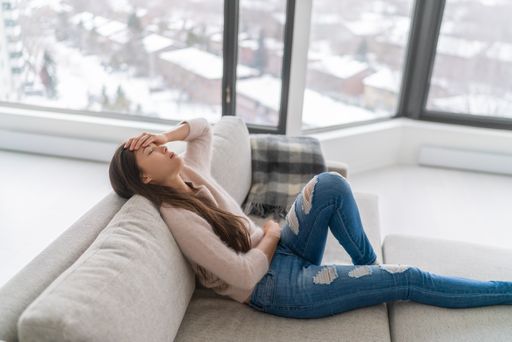Finding the Light Within the Darkness of Winter
By Jen Butler, MEd, BCC, DAIS
*This is an article from the Winter 2020/2021 issue of Contentment Magazine.

This is not another article on how 2020 sucks. This is an article about overturning a problem that affects over 10 million Americans every year, with 6% even requiring hospitalizations.1 This read gives you concrete, scientifically proven ways to avoid the consequences of season affective disorder (SAD).
So why bring up 2020 at the onset? Because going into the darkness of winter this year, many of us are already on the brink of anxiety and depressive disorders while living on or beyond our stress thresholds. A study by the CDC compared similar populations from June 2019 and June 2020 for symptoms of anxiety, depression, and strain. Anxiety disorders rose from 8.1% in 2019 to 25.5% in 2020; depressive disorders tripled (from 6.5% to 24.3%); and mental strain rose from 30.9% to 40.9%.2
What this comes down to is that more people will experience winter blues symptoms for the first time this year because their coping abilities are already depleted, putting them well on their way to SAD.
This is an article for you, your loved ones, your employees, and anyone who wants to find the light within the darkness of winter.
What Are the Winter Blues?
The winter blues commonly involve:
- Lethargy
- Gloominess
- Sleep difficulty
- Changes in eating patterns, especially seeking more carbs and comfort foods
- Mood alterations, with an increase in irritability and socially withdrawing.
The blues increase in the darker days of winter, typically starting in November and lasting through March.
They occur most often for those living 30-degrees or more north and south of the equator: north of Jacksonville, Florida; Austin, Texas; Cairo, Egypt; and Hangzhou, China; or south of Perth, Australia; Durban, South Africa; and Cordoba, Argentina.3 As many as 20% of the American population and 12.5% of the U.K. population experience winter blues symptoms that impact their daily lives just enough to be a nuisance but not enough to trample over all their joy.4
Unlike symptoms of SAD, the winter blues come and go throughout a day or week. For the most part, people enjoy their lives and handle their emotions, and few, if any, of their family, friends, and associates notice.
Then there are those people who consistently (year after year) and permanently (no ebb and flow) suffer from a compounding development of symptoms which definitely take over their lives and are noticeable to others. Seasonal affective disorder overwhelms their sense of joy and ability to cope and makes treatment necessary.
Why Do People Get SAD?
The specific causes for both the winter blues and seasonal affective disorder are unknown. According to the Mayo Clinic, scientists know there is a connection to lessening sunlight due to three main factors:
- Circadian rhythms –Your sleep-wake cycle is heavily regulated by the number of hours of darkness in a given day. The lack of sunlight in winter disrupts your internal clock, which in turn changes your sleep, mood, and appetite rhythms, leaving you sleepy, disoriented, and irritable.
- Melatonin overproduction –When it is dark outside, your body produces melatonin to prepare you for sleep. When the darkness of each day lengthens, the rise in melatonin may lead to a constant desire for sleep and an increase in grogginess.
- Serotonin underproduction- Serotonin is a neurotransmitter that helps regulate mood. Reduced sunlight in winter slows your body’s production resulting in a deficit of serotonin. You might feel depressive symptoms, such as lack of appetite, poor memory, and lack of sexual desire. Three critical risk-factors also attribute to the development of SAD: a family history of SAD or other depressive disorders, a diagnosis of major depressive disorder or bipolar disorder, and the distance you live from the equator. The good news is there are proven strategies to guide you to the light within the darkness of winter, avoiding winter blues and preventing SAD.
Find the Light
What medical professionals and researchers do know about SAD is that it is very treatable. It relies on finding the light in many forms and threading it into your daily routine.
- Use the Light
Unless you live in the farthest reaches from the equator, you have some sunlight each day during the winter months. A minimum of 30-minutes of exposure every day, especially in the morning, has been proven to reduce or eliminate SAD symptoms.5 Walk, work, play, stand, or sit in your car in the light to trigger the biochemical processes essential to avoiding SAD.
If exposure to natural sunlight is not possible, studies find that bright light works as a treatment. Early morning light therapy reduced SAD symptoms in two-thirds of patients with mild episodes and just under half with moderate to severe episodes in remission.6 It takes 1 to 2 weeks of consistent treatment for symptoms to begin to subside, and consistent use of light may prevent relapses throughout the winter.7 Communicating with family, co-workers, and employers about the importance of light therapy is essential in heightening their awareness and their empathy for your condition.
Like light, color has a major effect on mood. Posting colorful pictures around your home or work area will boost your mood — and why not lighten your wardrobe, color your hair, or paint your nails with a vibrant color? If the bright colors already around you seem dull and lifeless, you may be depressed and would benefit from consulting with a therapist.8
- Create Emotional Lightness
What do trees feel when the winter is over? Releaf.
Okay, maybe not the most sophisticated joke, but relief when spring comes is a feeling shared by most people with the winter blues or SAD. Reminding yourself that spring inevitably arrives may help you through the worst of winter.
Even more important, threading humor into your day will alleviate your symptoms. Humor connects you with other people, reduces tension, gives you a chance to find your objectivity, and allows you to express frustration in a positive way.9 Whether you listen to humor or create it, laughter is medically proven to reduce stress, anxiety, and even physical pain.10
In addition to looking forward and embracing humor, journaling is a significant help in handling winter blues and the symptoms of SAD. If you journal about your day and feelings during light therapy, you receive a double benefit.
Talk to someone who is sympathetic to your situation — a friend, family member, or therapist who understands that the winter blues and SAD are not something you can simply turn off. They may provide support and companionship as you try to keep your diet, exercise routine, and light therapy on track. When you feel too overwhelmed to eat properly or exercise outside, the encouragement of others will help.
- Find Spiritual Light
Meditation is accessible to everyone, through free online courses and apps for your phone or laptop. By turning to meditation during your light therapy or just before you go to sleep at night, you increase the benefit without interfering with your other activities.
Spiritual light is compromised by negative messages and people. Concentrate on positive interactions (lunch with a good friend, a walk with a loved one) and positive social media. If the news causes you to stress, stay away from the news — history tells us that very little ever happens that hasn’t happened before.
Consider volunteering. Many nonprofit organizations in your community would welcome a volunteer, and the benefits include an increase in life satisfaction, self-esteem, and happiness. One survey of over 1,500 adults found that depressive symptoms decreased by over 4% and mental and physical health increased by over 7% each with voluntarism.11
- Build Strong Mental Light
Keeping mentally active is a good tactic, not only for distracting you from a depressive mood, but also for boosting your self-confidence, energizing your conversation, and improving your skills. You might try to master a new subject through reading and research, take an online course, or try a new hobby.
If you find yourself slipping into forgetfulness, inattention, and obsessive, repetitive thinking during the winter, try video games. Medical research suggests that video games improve cognition and coping ability while reducing stress and depression. Cooperative games immerse players in an online community, providing the benefits of social interaction.12
How much video gaming is too much? Experts vary on their answers, although some consider the moderate play of 7 to 10 hours a week optimal for mental health and anything over 10 to be excessive. Most experts agree that you have to monitor yourself: if your symptoms become worse (your sleep and nutrition suffer, for example), you are playing too much.
- Aim for Physical Lightness
For most people, winter is the most difficult time to begin a diet, and if you are already stressed and depressed, you do not need the additional stress of trying to lose weight. But you should be able to maintain your weight if you grab opportunities to walk outdoors or attempt to learn a winter sport, such as snowshoeing or skiing.
When carbohydrates beckon, satisfy the craving with whole grains (oatmeal for breakfast, multi-grain bread for toast). Instead of candy and sugar-loaded snacks, try fruits and vegetables, especially those with bright colors.
You may want to talk with your doctor about getting enough Vitamin D. Be careful about taking Vitamin D supplements on your own, as they may overload your system.
Conclusion
Although 2020 has brought many events that are out of our control, good health and happiness are within reach if we find the light in the darkness of winter. Light from the sun, emotional light from humor and personal connection, spiritual light from meditation and volunteering, mental light from gaming and education, and physical light from exercise and good nutrition — they all help us cope and enjoy life when winter blues or SAD threaten.
If you need additional support, reach out to a family member, friend, co-worker, or therapist who understands your efforts — and remember that springtime always comes again.
References:
- Seasonal Affective Disorder. Psychology Today, February 2007. https://www.psychologytoday.com/us/conditions/seasonal-affective-disorder
- Czeisler M.É., Lane R.I., Petrosky E., et al. Mental Health, Substance Use, and Suicidal Ideation During the COVID-19 Pandemic — United States, June 24–30, 2020. Morbidity and Mortality Weekly Report (MMWR), 2020;69:1049–1057. https://www.cdc.gov/mmwr/volumes/69/wr/mm6932a1.htm?s_cid=mm6932a1_w
- Robinson, L., Shubin, J., and Segal, J. Seasonal Affective Disorder. HelpGuide, August 2020. https://www.helpguide.org/articles/depression/seasonal-affective-disorder-sad.htm
- Parkinson, J. and de Castella, T. Seasonal Affective Disorder and the Difference from Winter Blues. BBC News, December 2, 2014. https://www.bbc.com/news/magazine-30282261
- Seasonal Affective Disorder. Mayo Clinic, 1998-2020. https://www.mayoclinic.org/diseases-conditions/seasonal-affective-disorder/symptoms-causes/syc-20364651
- Partonen, T. and Lönnqvist, J. (1998) Seasonal Affective Disorder. Mol Diag Ther, 9, 203–212. https://doi.org/10.2165/00023210-199809030-00004
- Wu, D. (2017, Jan 23). Let the Sun Shine: Mind Your Mental Health This Winter. Harvard Health Publishing. https://www.health.harvard.edu/blog/let-the-sun-shine-mind-your-mental-health-this-winter-2017012311058
- Jones, J.W. (2018, Aug 8). Decreased Perception of Color in Depression. PsychCentral. https://psychcentral.com/news/2010/07/21/decreased-perception-of-color-in-depression/15826.html
- Kinsman Dean, R.A., Major, J. (2008) Humor Plays an Important Role in Healthcare Even When Patients Are Terminally Ill. Journal of Clinical Nursing, 17(8), 1088-1095. https://doi.org/10.1111/j.1365-2702.2007.02090.x
- Bennet, H. (2003) Humor in Medicine Southern Medical Journal, 96(12), 1257-1261. https://www.utmb.edu/gem/pdfs/humor_in_medicine.pdf
- Yueng, J.W.K., Zhang, Z., and Kim, T.Y. (2017) Volunteering and Health Benefits in General Adults: Cumulative Effects and Form. BMC Public Health, 17(736). https://www.ncbi.nlm.nih.gov/pmc/articles/PMC5504679/#:~:text=Likelihood%20ratio%20estimates%20found%20that,decrease%20in%20depression%2C%20giving%20evidence
- Jones, C.M., Scholes, L., Johnson, D., et al. (2014, Mar 31) Gaming Well: Links between Videogames and Flourishing Mental Health. Frontiers in Psychology. https://doi.org/10.3389/fpsyg.2014.00260
ABOUT THE AUTHOR
 Jen Butler is the owner, founder, and CEO of JB Partners, a company committed to reducing the stress of private-practice owners, small businesses, and large organizations through intuitive and powerful programming, one-to-one coaching, and comprehensive consulting. While earning two bachelor’s degrees-one in Public Health Administration and the other in EducationalPsychology-Jen worked in hospitals, private practices, and became a paramedic, learning first-hand the challenges and relentless stress faced by medical professionals. Building on her education and 25-years of experience in learning &development, Jen Butler has worked with entrepreneurs, small business owners, corporate leaders, and executives on how to obtain sustainable profitability with less stress and more fulfillment. Jen is also a Diplomate of The American Institute of Stress. If you would like to learn more about the great programs at JB partners just go to jbpartners.com.
Jen Butler is the owner, founder, and CEO of JB Partners, a company committed to reducing the stress of private-practice owners, small businesses, and large organizations through intuitive and powerful programming, one-to-one coaching, and comprehensive consulting. While earning two bachelor’s degrees-one in Public Health Administration and the other in EducationalPsychology-Jen worked in hospitals, private practices, and became a paramedic, learning first-hand the challenges and relentless stress faced by medical professionals. Building on her education and 25-years of experience in learning &development, Jen Butler has worked with entrepreneurs, small business owners, corporate leaders, and executives on how to obtain sustainable profitability with less stress and more fulfillment. Jen is also a Diplomate of The American Institute of Stress. If you would like to learn more about the great programs at JB partners just go to jbpartners.com.
Contentment Magazine
The dictionary defines “content” as being in a state of peaceful happiness. The AIS magazine is called Contentment because we want all of our guests and members to find contentment in their lives by learning about stress management and finding what works best for each them. Stress is unavoidable, and comes in many shapes and sizes that makes being in a state of peaceful happiness seem like a very lofty goal. But happiness is easy to find once you are able to find ways to manage your stress and keep a healthy perspective when going though difficult times in life. You will always have stress, but stress does not always have you!

Leave A Comment
You must be logged in to post a comment.